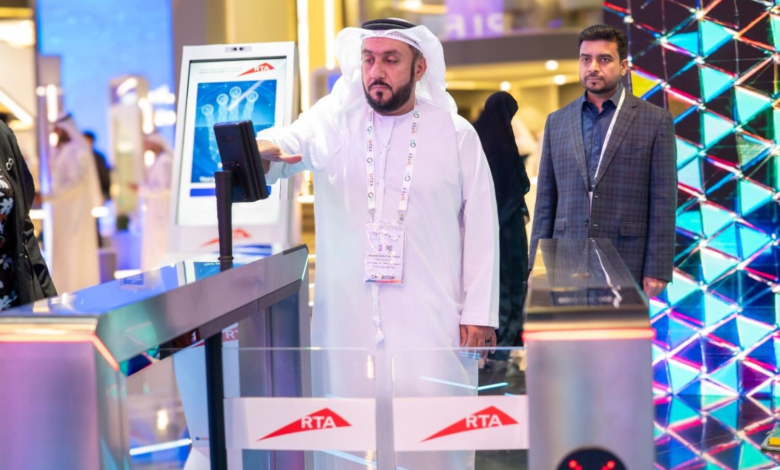
Dubai to Roll Out Pay-by-Palm System for Metro by 2026
Dubai’s public transport system is set for a major upgrade with the Pay-by-palm system at Metro stations expected to be rolled out by 2026. This innovative technology, spearheaded by the Roads and Transport Authority (RTA), aims to revolutionize how commuters access and pay for their journeys on the Dubai Metro. The palm readers will offer a seamless, contactless payment method, aligning with Dubai’s vision for futuristic and efficient transportation.
The introduction of palm-based payment is part of broader Metro station technology upgrades planned for 2026. This advancement in biometric authentication for public transit promises to enhance the travel experience, offering a secure and convenient alternative to traditional payment methods like the nol card. As Dubai continues to lead in transportation innovations, the palm payment system represents a significant step towards cashless travel and modernized public transport infrastructure in the emirate.
Dubai’s Vision for Futuristic Public Transport
Dubai’s Roads and Transport Authority (RTA) is at the forefront of transforming the city’s public transport system into a futuristic marvel. The RTA’s commitment to innovation has led to the development of groundbreaking projects that aim to revolutionize the way people move around the city.
RTA’s commitment to innovation
The RTA has established five innovation pillars to drive its vision forward: Innovation Governance, Innovation Culture, Innovation Talent, Innovation Process, and Future Foresight. These pillars guide the authority in deploying innovative products and solutions, fostering a risk-taking mindset, and enhancing internal processes using emerging technologies. The RTA’s innovation portfolio boasts over 150 projects, including breakthrough initiatives such as Air Taxis, Smart Yards, and Hyperloop concepts.
Integration with UAE Vision 2031
Dubai’s public transport advancements align closely with the UAE’s national vision, “We the UAE 2031.” This alignment has resulted in the creation of a knowledge-sharing digital platform that utilizes AI-powered strategic design models. The platform pools vast amounts of knowledge from global sources and experts, informing policymakers and government leaders in executing national plans. This integration ensures that Dubai’s transport innovations contribute to the broader goal of positioning the UAE as an attractive and influential economic hub.
Timeline for implementation
The RTA has set ambitious timelines for implementing its futuristic transport solutions. The pay-by-palm system at Metro stations is expected to be rolled out by 2026, marking a significant step towards contactless and efficient travel. Additionally, the RTA aims to launch aerial taxi services by 2026, connecting key areas such as Dubai International Airport, Downtown Dubai, Palm Jumeirah, and Dubai Marina. These initiatives are part of Dubai’s plan to make 25 percent of all public transport autonomous by 2030, showcasing the city’s commitment to leading the way in smart mobility solutions.
How the Pay-by-Palm System Works
Palm vein recognition technology
The pay-by-palm system utilizes advanced palm vein recognition technology, which scans the unique vein patterns in a person’s hand. This biometric method is highly accurate and secure, as vein patterns are internal and difficult to replicate. The system uses near-infrared light to capture an image of the veins, which appear as a dark pattern due to the absorption of light by deoxidized hemoglobin. This image is then processed and encrypted, creating a unique biometric ID for each individual.
Registration process
To register for the pay-by-palm system, users will need to visit designated kiosks at Dubai Metro or bus stations. The process involves selecting the ‘Register nol card’ option on the touchscreen, scanning the existing nol card, and then holding each palm about 15 cm above the scanner. The system captures over 5 million data points from each palm, ensuring high accuracy and security. This one-time registration links the user’s palm print to their nol card account.
Integration with existing Nol card system
The pay-by-palm system seamlessly integrates with the existing nol card infrastructure. Once registered, users can simply hover their hand over a sensor at metro gates or other public transport points to pay for their journey. The fare is automatically deducted from the linked nol card balance, eliminating the need to carry physical cards or remember PINs. This integration extends beyond metro stations, potentially allowing palm-based payments at cafes and other points of sale that accept nol cards.
Benefits and Challenges of Palm Payment
Increased convenience for commuters
The pay-by-palm system at Dubai Metro stations is set to revolutionize the way commuters access and pay for their journeys. This innovative technology offers a seamless and swift payment process, eliminating the need for traditional methods like swiped cards or entering PINs. Commuters can simply hover their hand over a sensor to complete transactions, streamlining the entire process and reducing waiting times at metro gates. This contactless approach also addresses hygiene concerns in a post-pandemic world, as users don’t need to touch any surfaces to make payments.
Enhanced security features
Palm vein recognition technology provides a highly secure method of biometric authentication. The unique vein patterns in a person’s hand are virtually impossible to replicate, making this system more secure than traditional payment methods. The technology uses near-infrared light to capture an image of the veins, which is then encrypted and stored as a unique biometric ID. This enhanced security feature offers peace of mind to commuters, reducing the risk of fraud and unauthorized transactions on the Dubai Metro.
Potential concerns and solutions
Despite its benefits, the implementation of palm payment technology raises some concerns. Privacy is a primary issue, as the collection of biometric data may worry some users. To address this, the Roads and Transport Authority (RTA) must ensure robust encryption measures and transparent policies regarding data usage and storage. Another challenge is the initial cost of implementing the technology, which may be high for the RTA. However, the long-term benefits of increased efficiency and security could outweigh these initial expenses. Additionally, ensuring system reliability and addressing potential technical glitches will be crucial for widespread adoption and user satisfaction.
Broader Applications Beyond Metro Stations
Extension to busses, trams, and marine transport
The pay-by-palm system is set to revolutionize Dubai’s entire public transport network. Beyond metro stations, the Roads and Transport Authority (RTA) plans to extend this innovative payment method to busses, trams, and marine transport services. This expansion will create a seamless travel experience across various modes of transportation. Commuters will be able to use their palm to pay for journeys on busses, water taxis, and the Dubai Tram, eliminating the need for multiple payment methods and enhancing convenience for residents and tourists alike.
Potential use in retail and hospitality sectors
The applications of palm payment technology extend far beyond public transportation. The RTA is exploring opportunities to integrate this system with retail and hospitality sectors. In the future, Dubai residents and visitors may be able to make purchases at cafes, restaurants, and shops using their palm print. This expansion aligns with the city’s vision of creating a cashless society and enhancing the overall customer experience across various industries. The integration of palm payments with existing nol card infrastructure could potentially allow users to pay for goods and services at hundreds of vendors throughout the UAE.
Future of contactless payments in Dubai
As Dubai continues to embrace cutting-edge technology, the future of contactless payments looks promising. The city is positioning itself as a global leader in smart payment solutions, with biometric authentication at the forefront. The introduction of palm vein recognition technology is just the beginning of a broader shift towards more secure and convenient payment methods. As the system evolves, it may integrate with other financial services, such as investment platforms and budgeting tools, creating a comprehensive digital wallet ecosystem. This innovation is set to transform how people interact with businesses and services, making Dubai an even more attractive destination for tech-savvy residents and tourists.
Dubai’s ambitious plan to introduce palm payment technology in its metro stations by 2026 marks a significant step towards a more efficient and secure public transport system. This cutting-edge biometric solution is set to have a profound impact on the daily lives of commuters, offering a seamless and hygienic way to pay for travel. The integration of this technology with the existing nol card system shows Dubai’s commitment to enhancing user experience while maintaining compatibility with current infrastructure.
Looking ahead, the potential of palm payment technology extends far beyond metro stations, with plans to implement it across various modes of transport and even in retail and hospitality sectors. This forward-thinking approach aligns perfectly with Dubai’s vision to become a global leader in smart city solutions. As the emirate continues to push the boundaries of innovation, the pay-by-palm system serves as a prime example of how technology can be harnessed to improve urban living and solidify Dubai’s position as a city of the future.







[…] than 2 million Dubai residents use Nol Dubai services daily. We’re thrilled to announce a new development that will change how our community […]
[…] The Dubai Metro extended its operational hours to help participants reach the venue. Both Red and Green Lines ran from 3 AM to midnight. Participants needed minimum Nol card balances of AED 15 for Silver cards and AED 30 for Gold cards. […]